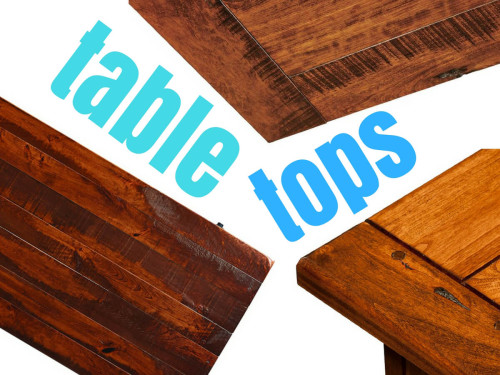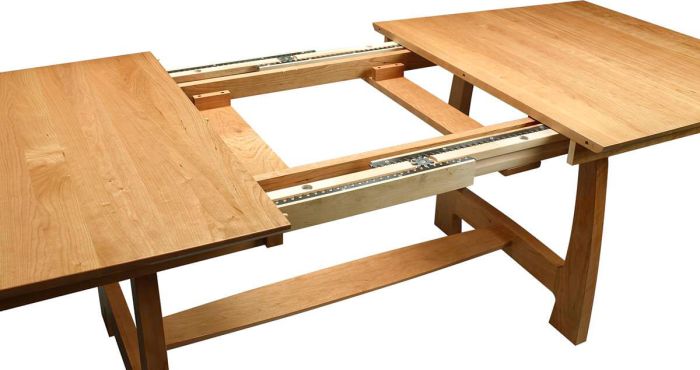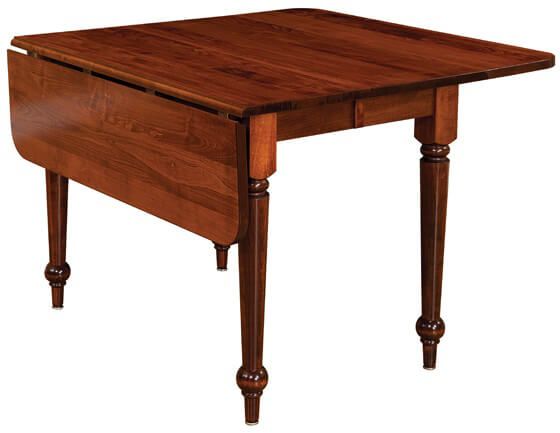Dining Table Tops: Which One Is Right For Me?
By Bailiegh Basham · January 5, 2017
Plank Tops, Breadboard Ends, and Leaf Style Tables
When buying a solid wood dining table, one must first determine the wood species one prefers. If you are still undecided, this guide may help.
Secondly, a consumer will determine the size of the table needed to fit the space, family, and special occasion needs of the home in question. If you haven't determined the size table you need, there are guides to help with that too. Seating guides for tables are provided.
Expansion potential is the third component of a buyer's decision. If your everyday size needs differ greatly from your special occasion needs, then expansion leaves are a viable option to help one table accommodate both needs. Countryside offers kitchen and dining tables that expand traditionally and also with a butterfly leaf, a drop leaf, or a refectory leaf.
What is the difference between a standard leaf and a butterfly leaf?
A standard leaf usually has a smooth surface and is 12"L. That is to say if your base table size is 42"W X 60"L it becomes 42"W X 72"L when you add one 12" leaf. Leaves will be cut at the width of the dining table's base size.
Leg tables usually open on wood slides and the entire table slides apart.
Pedestal or trestle tables usually open on geared slides so that the pedestal or trestle does not expand or move, the table top merely opens as the base remains stationary.

A butterfly leaf will have two seams: the first is just like a standard leaf where the leaf and table meet. The second is a center seam that allows the butterfly leaf to "fold". Butterfly leaves for our Amish tables are almost always 18". The mechanism of the butterfly leaf is metal, but the other expansion details for leg and pedestal or trestle tables are consistent.
Ultimately, both traditional and butterfly leaves will self-store and expand your kitchen or dining table lengthwise. Which mechanism you choose is a matter only of preference, neither will alter the basic appearance of the table you choose.
What are drop leaf tables and refectory tables?
Drop leaves are exactly what they say they are: leaves that "drop". This table expands by lifting the leaves from a resting, or folded, position. The size of these leaves varies widely.
Refectory tables expand at the ends like drop leaf tables, only they are stored differently. Early American period correct, these tables tuck leaves under the ends for storage or they are taken off completely, depending on the style. These, too, vary in size.
What is a planked table top?
Most of our Amish made dining tables are hand sanded many times over to create a buttery smooth surface for staining and finishing. These are our standard tops and this smoothness can be accomplished on any of the wood species we offer.
"Planking" a top can be accomplished in two ways. For a rustic kitchen or dining room, an authentic feel can be created by using planks that are actually separate pieces of wood.
This is a technique we do not use often due to the inability to limit board warping over time and the actual gaps that can form in the table top over time. Unless being period perfect is critically important to you, we do not recommend this planking method.
Far more often, our plank top tables feature cosmetic grooves in a solid table top that allow it to appear planked. The grooves are fairly superficial, but allow the boards to work together without causing gaps.
The appearance is not discernably different, but the longevity of your solid wood table is better assured using this method. It is important to note that leaves may be added to plank top tables, but they are typically larger due to the design. 16" is usually the length gained from a single planked expansion leaf.
Farmhouse tables and rustic tables of all kids utilize plank tops with varying degrees of distressing. Almost all of these rugged tops, however, feature a breadboard end.
This end piece serves the functional purpose of creating resistance to the natural expansion of this solid wood top over time. It is also period correct and beautiful. The tongue and groove joinery is exposed as is the dowel pin. These details authenticate both the craftsmanship of these Amish made tables as well as the style. In some cases, a breadboard end can be employed without a planked top.
A variety of rustic options can be applied to your custom dining room table, but these are the basic choices with which you will be presented in our Create Your Piece menu. Edge profiles and Shapes are also important, but hopefully you now have a better understanding of how your table top functions.


